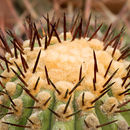fr
noms dans le fil d’Ariane


Copiapoa is a genus of flowering plants in the cactus family Cactaceae, from the dry coastal deserts, particularly the Atacama Desert, of northern Chile.
It comprises 32 morphologically defined species and 5 heterotypic subspecies.[1] The species in the genus Copiapoa forms dense cushions of hundreds of large individual plants or produce only solitary plants. The shoots are spherical or elongated-cylindrical. The spines, which are usually present, are variably shaped. On the apex, the species are usually densely woolly-haired. The ribs are clearly developed. These species vary in form from spherical to slightly columnar and in color from a brownish to blue-green body. They have warty ribs and spiny areoles, and they usually produce tubular yellow flowers which grow from woolly crowns on the apex in summer. They are bell- to funnel-shaped and open during the day. The short, circular pericarp is glabrous. The flower tube is short and broad. The small, smooth fruits contain large, shiny black seeds.[2]
Pilocopiapoa F.Ritter has been brought into synonymy with this genus. Some authorities also include here the genus Blossfeldia.
Species of the genus Copiapoa according to Plants of the World Online As of January 2023[3] separated according to sections.[4][5]
{{cite journal}}: CS1 maint: DOI inactive as of January 2023 (link) Copiapoa is a genus of flowering plants in the cactus family Cactaceae, from the dry coastal deserts, particularly the Atacama Desert, of northern Chile.